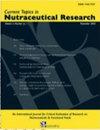Identification of Ferroptosis-Related Genes in Acute Ischemic Stroke Based on Bioinformatics Analysis and Prediction of Potential Therapeutic Drugs
IF 0.4
4区 医学
Q4 NUTRITION & DIETETICS
Current Topics in Nutraceutical Research
Pub Date : 2023-07-20
DOI:10.37290/ctnr2641-452x.21:306-314
引用次数: 0
Abstract
Ferroptosis is a regulated cell death implicated in various diseases, including stroke. We have explored the ferroptosis related key genes and the underlying association with acute ischemic stroke. Differentially expressed mRNAs and miRNAs in ischemic stroke were screened based on the GSE16561 and GSE95204 datasets, respectively. Ferroptosis-related genes were downloaded from the FerrDb and GeneCards databases. Eleven ferroptosis-related differentially expressed genes were identified. Based on weighted gene co-expression network analysis, three key modules were identified as being closely associated with stroke. Furthermore, two hub genes, lysosomal associated membrane protein 2 and signal transducer and activator of transcription 3, were selected by a support vector machine-based recursive feature elimination algorithm based on machine learning and showed excellent diagnostic accuracy in stroke, with an area under the curve value of 0.939 and 0.875 in the GSE16561 cohort, respectively. Furthermore, the Comparative Toxicogenomic Database predicted 24 potential therapeutic drugs targeting the two hub genes. To sum up, the identification of hub genes associated with ferroptosis and acute ischemic stroke based on bioinformatics analysis may contribute to the exploration of promising diagnostic and therapeutic biomarkers and provide clues for the prediction of therapeutic candidates.基于生物信息学分析和潜在治疗药物预测的急性缺血性卒中中铁中毒相关基因鉴定
铁下垂是一种受调控的细胞死亡,涉及多种疾病,包括中风。我们探讨了铁下垂相关的关键基因及其与急性缺血性卒中的潜在关联。分别基于GSE16561和GSE95204数据集筛选缺血性卒中中差异表达的mrna和mirna。从ferdb和GeneCards数据库中下载了嗜铁性凋亡相关基因。鉴定出11个与铁衰相关的差异表达基因。基于加权基因共表达网络分析,确定了与脑卒中密切相关的三个关键模块。此外,通过基于机器学习的支持向量机递归特征消除算法选择溶酶体相关膜蛋白2和信号换能器和转录激活因子3两个枢纽基因,在卒中诊断中表现出良好的准确性,GSE16561队列的曲线下面积分别为0.939和0.875。此外,比较毒物基因组数据库预测了24种针对这两个中心基因的潜在治疗药物。综上所述,基于生物信息学分析鉴定与铁死亡和急性缺血性卒中相关的枢纽基因,有助于探索有前景的诊断和治疗生物标志物,并为预测治疗候选药物提供线索。
本文章由计算机程序翻译,如有差异,请以英文原文为准。
求助全文
约1分钟内获得全文
求助全文
来源期刊
CiteScore
1.10
自引率
0.00%
发文量
36
审稿时长
>12 weeks
期刊介绍:
Current Topics in Nutraceutical Research is an international, interdisciplinary broad-based peer reviewed scientific journal for critical evaluation of research on chemistry, biology and therapeutic applications of nutraceuticals and functional foods. The major goal of this journal is to provide peer reviewed unbiased scientific data to the decision makers in the nutraceutical and food industry to help make informed choices about development of new products.
To this end, the journal will publish two types of review articles. First, a review of preclinical research data coming largely from animal, cell culture and other experimental models. Such data will provide basis for future product development and/or human research initiatives. Second, a critical evaluation of current human experimental data to help market and deliver the product for medically proven use. This journal will also serve as a forum for nutritionists, internists, neurologists, psychiatrists, and all those interested in preventive medicine.
The common denominator of all of the topic to be covered by the journal must include nutraceuticals and/functional food. The following is an example of some specific areas that may be of interest to the journal. i) Role of vitamins, minerals, antioxidants and phytonutrients on cardiovascular health, cancer, diabetes, ocular health, mental health, men’s health, women’s health, infant nutrition, ii) Role of herbals on human health, iii) Dietary supplements and sleep, iv) Components of diet that may have beneficial effect on human health, v) regulation of apoptosis and cell viability, vi) Isolation and characterization of bioactive components from functional foods, vii) Nutritional genomics, and viii) Nutritional proteomics.

 求助内容:
求助内容: 应助结果提醒方式:
应助结果提醒方式:


